Lanzarote and Etna's Sicily; the Catalan comarca of La Garrotxa and Oregon; Hawaii and Iceland; Azores and Philippines; Cantal, in France, and La Palma, in the Canaries – like Lanzarote - as well as the recent scenery of a spectacular and dramatic eruption. And so on. Regions of the planet that differ greatly from one another... Or not: because they all share their being volcanic, characterised by the presence of craters – sometimes quiescent for centuries, sometimes still active – whose activity has marked their history and geology, orography, and morphology. And it's a change of perspective that was fiercely presented at Worldcanic, the first congress dedicated to "volcanic cuisine" which took place in Lanzarote a few days ago.
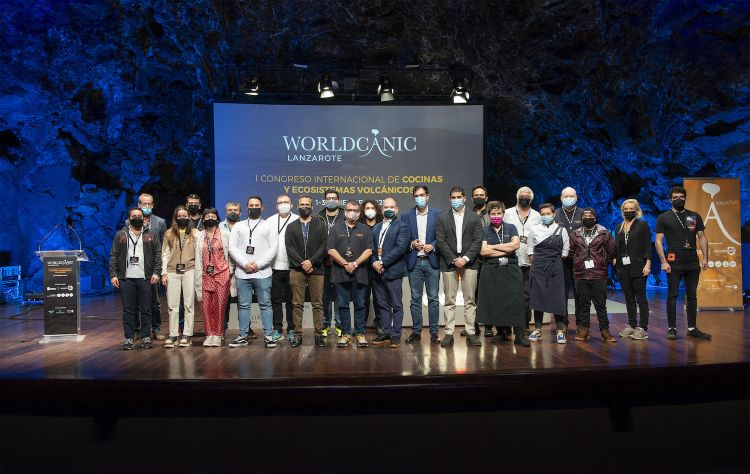
A group photo with the speakers
We can sum up like this, the total change of point of view: volcanic activity is not (just) destruction, but in fact it's life; lava, lapilli and ashes are a bugbear at the very moment, but they nourish the soil. They contain a very high percentage of minerals and, if mixed with the soil, nutrients like phosphates, nitrates, potassium and calcium, which are necessary for the plants' healthy development. Volcanic soils are usually based on basalt, and this make them richer than any other soil; they are also "new", that is to say freshly erupted in the “upper” world, and thus "fresh", rich in all the elements that are available in the earth's crust. When rain falls over volcanic soil, it melts these elements and makes them available to plants, which grow better. This is the answer we could give to a common question: why do people live on an active, potentially dangerous volcano? Are they mad? They're not: the main factor is the exceptional fertility of those areas. Their higher agricultural production matched with the superior quality of the products.
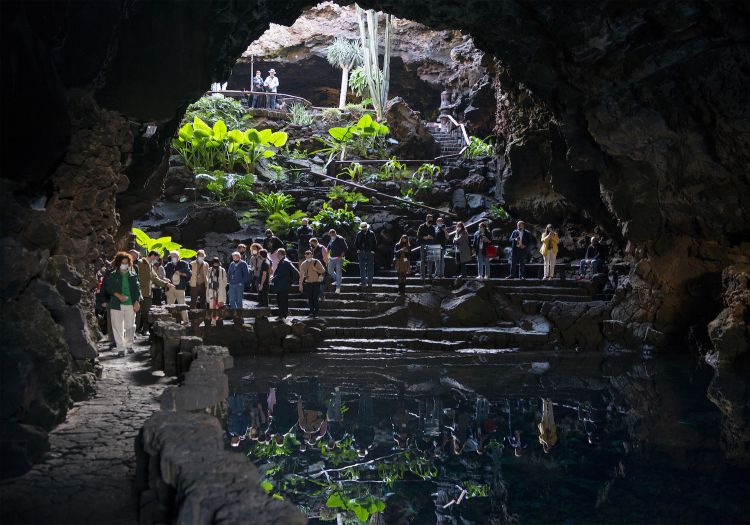
Worldcanic took place in beautiful places in Lanzarote. Here you see the Jameos del Agua, a natural place and artistic, cultural and touristic centre created by César Manrique (a polyhedric artist, painter, sculptor, architect, ecologist, preserver of the artistic heritage, urban and landscape designer from Lanzarote). He convinced the other locals to invest in tourism without making the mistakes made in other areas of the country and of the planet, thus not allowing to ruin the landscape with buildings that would not be in tune with the volcanic nature of the island). The Jameos del Agua are one of the most appreciated destinations. The word jameo has Aboriginal origins and refers to a hole made when the roof of a lava tunnel collapses. Jameos del Agua can be found inside the volcanic tunnel produced by the eruption of the volcano de la Corona. The known length of the tunnel is 6 km, of which at least 1.5 km under the sea: this latter section is called Tunnel of Atlantis. The Jameos del Agua are in the section of this tunnel that is close to the coast. They are made of at least three “jameos”, or openings in the soil
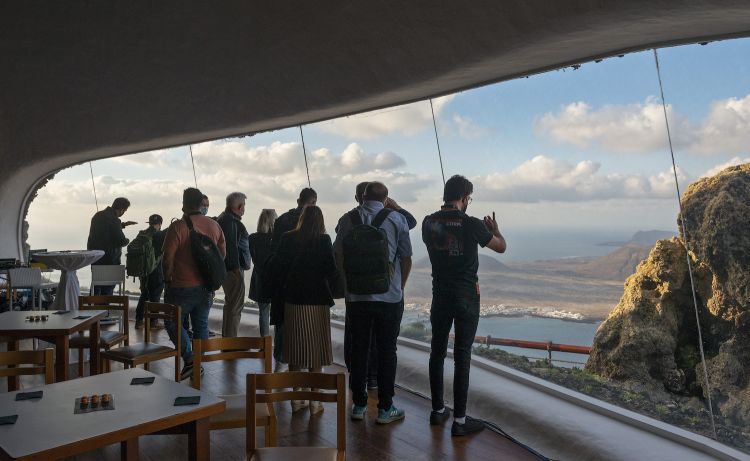
The Mirador del Río, the most famous viewpoint in Lanzarote, at 496 metres above the sea level. It's one of the most emblematic architectural creations of Manrique. It was built so it would be completely camouflaged by the environment, on top of the magnificent coast of Risco de Famara, near the village of Yé, on the most northern tip of Lanzarote. It dominates El Río, the tight strip of sea that separates Lanzarote from La Graciosa
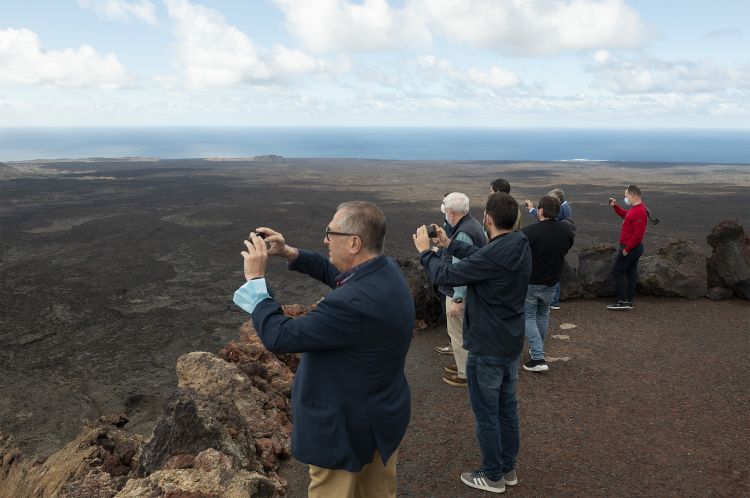
Cooking on a "crater" using the heat of the volcano's magma at El Diablo, a restaurant perched in the heart of the National Park of Timanfaya, on the Montañas del Fuego
This and much more was discussed at
Worldcanic, three very intense and well-structured days. It featured not only chefs, but also geologists, journalists, cheese producers (volcanic cheese!), farmers, scientists, wine producers. All united by their respect for volcanoes, by their research, by their awareness of their importance.
Here is our summary of the best we've attended. Starting, as we did here, from the words of Benjamin Lana, general director at Vocento Gastronomía, the division dedicated to food events that is part of the big Spanish editorial group Vocento, and which organised Worldcanic too: «Cooking is the only sector that can connect different fields, tourism, to begin with, but also the primary sector», and then science, culture, history... And even a little geology.
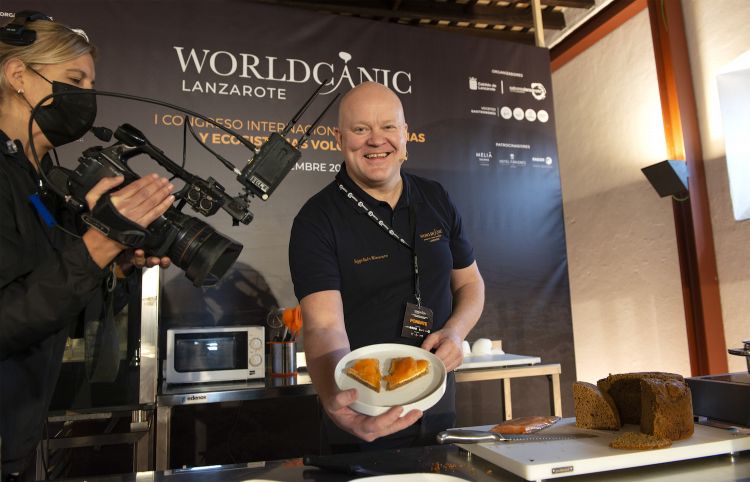
Sigurour Rafn Hilmarsson and his bread cooked under the soil with volcanic heat
Sigurour Rafn Hilmarsson has a complicated name but a calm attitude. He's the chef and patron at
Laugarvatn Fontana Geothermal Spa, a hotel and geothermal wellness centre overlooking the black beach of Laugarvatn, in Iceland. He doesn't just use the volcanic heat for saunas; he cooks even bread in the soil, which is boiling for the springs. In a pot he mixes rye, flour, sugar, yeast, salt and puts it under the soil, «we leave it there for 24 hours», then he uncovers it and serves it in slices, with smoked trout and Icelandic butter. This is how it all began for him: «One day I put a sign at the reception asking our guests if they might be interested in a demonstration of geothermal bread cooking. The next day 80 guests appeared, and since then it's been a regular event». This bread is based on an ancient recipe, popular among many Icelandic families, who also use the same natural heat «to grow the vegetables we used to import. It gave us independence», says
Hilmarsson.
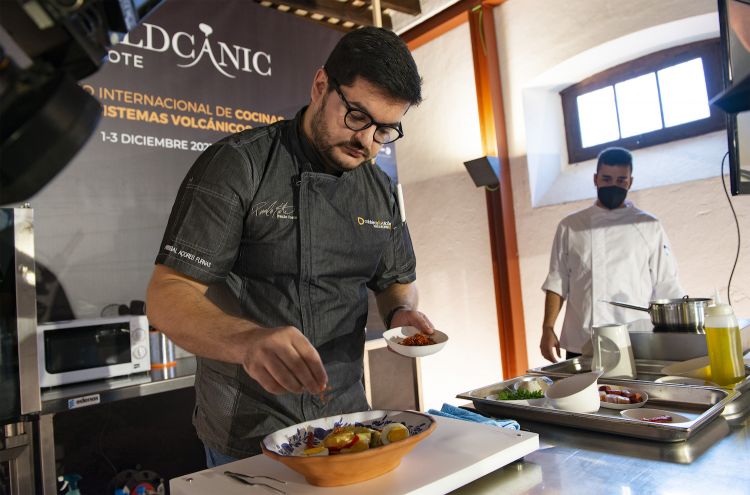
Paulo Costa at Worldcanic and, below, his Caldeira con bacalao, a recipe prepared putting all the ingredients in a pot close to the thermal waters of São Miguel, the largest island of the Azores
The same logic – confirming that the energy of the volcanoes is shared by place very distant from one another – is applied by
Paulo Costa, chef at
Caldeiras & Vulcões in Furnas, Azores, the distant Atlantic archipelago of Portugal. In this case too, the inspiration comes from a traditional recipe,
cozido das furnas (more or less “stew of the volcanoes”), the most famous and typical of the island, «a recipe almost 100-years-old that you have on holidays, especially at Christmas». This is how it works: «You start the day before by putting the meat - beef, chicken, pork – and the vegetables into a pot, with sausages and blood sausage on top to give extra flavour. At 3 am you bury everything in the calderas of the thermal waters of São Miguel, the largest of the Azores islands, in places where these waters run with stronger intensity and closer to the surface», a temperature of around 100°C. You leave them there for around 6-7 hours.
Costa has added some variations to the recipes, using the same technique to cook salted cod instead of meat, adding some flavour with chorizo and saffron, peppers, carrots, potatoes, onions. And broth. We tasted the result: simply delicious.
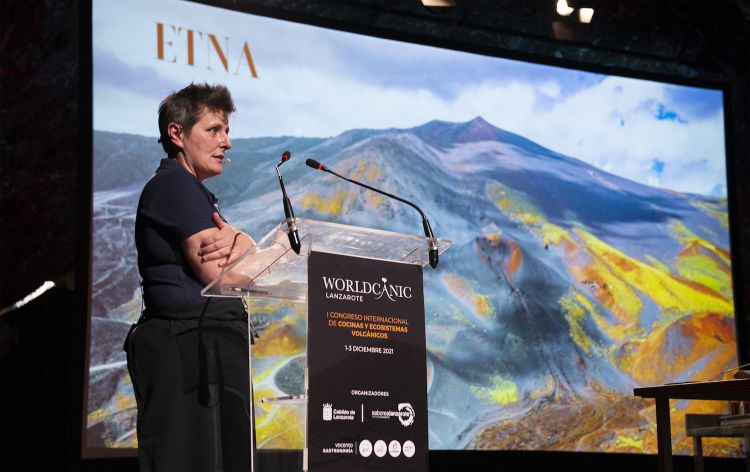
Viviana Varese at Worldcanic...
's Italian guest,
Viviana Varese, spoke about the (volcanic) fertility of her magnificent biodynamic vegetable garden, with over 100 varieties of seeded plants and 1000 square metres in Noto, which is the pantry of delicacies for her new
W Villadorata Country Restaurant – we
wrote about it here – as well as a place of social inclusion, «we have immigrants working with us, and people who need to be reincluded into society».
Viviana went from one volcano to the other, having been born in Salerno, a few km from Vesuvius, and being now based – on top of Milan and her starred restaurant
ViVa – also in the beautiful countryside of Noto, with Etna around 100 km away. Which is not a lot, as she tells herself: «Almost three quarters of the Sicilian agricultural production is influenced by what in Sicily we call
a' muntagna [the mountain]. Volcans mean fertility» and then comes a series of aromas and flavours that the chef has come across, «from traditional apples to over twenty ancient wheat varieties, from grapes to beans, of ten different kinds, of which I grow the
Badda variety, a Slow Food Presidium. And then there's Sicilian bees! And almonds! Sicily is the region with the highest number of Presidia in the world, 52, a testimony of an extraordinary biodiversity». A heaven of natural goodness that
Varese prefers to use raw more and more often: already in the first summer – last summer – of
W Villadorata, three days a week were dedicated to chargrilling, with an outdoor wood oven, for a menu called
Fuoco. Come winter, the restaurant will also make use of a new cast iron stove, inside the kitchen, «so I will be able to make parrilla even when the weather is bad outside». She gives a proof of this at
Worldcanic with some recipes that use embers, flames, and the warmth of the earth. Like when she dips some marvellous prawns wrapped in lemon leaves in a bowl full of salt, egg white, and powdered coal. She cooks it in an «old style» wood oven, forming a sort of "crust" which is then broken to recover the seafood, and in which the coal gives a subtle smokiness, serving the prawns with basil oil, pepper and powdered orange leaves, with a salad of prickly pear leaves on the side, plus twenty types of tomatoes, onion, some more basil oil, lemon juice and orange zest. Marvellous.
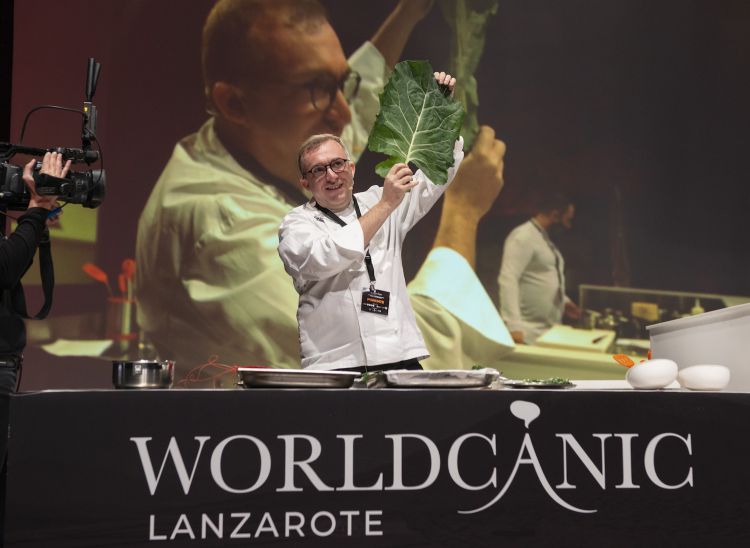
Chele González shows the leaves of taro and, below, the dish he made at Worldcanic, a synthesis of the Philippines, Lanzarote and Cantabria
is Spanish, from Cantabria, but has been working for 11 years in his restaurant
Gallery By Chele – number 90 in the
Asia's 50 Best Restaurants – in Manila, in the Philippines, one of the countries with the largest number of active volcanoes in the world, where the latest eruption was that of Taal, very close to the capital, shortly before the pandemic. He speaks about his use of products grown on volcanic soil, and of the technique of slow cooking with fire, «the Aeta people, indigenous Philippine people, know very well the meaning of cohabiting with volcanoes. They even acknowledged that they changed culture after the eruption of Pinatubo in the Nineties. They know that the volcano is their best support-system, that it makes the soil fertile». He presented an adaptation of a dish that he offers in his restaurant, and which is inspired by a traditional Filipino dish,
pinangat. In Manila he wraps white prawns in leaves of taro, «a very strong plant that grows around the Mayón volcano»; at
Worldcanic he adapts and mixes the island of the Canaries with his Cantabria and the Philippines, wrapping the local carabineros in blanched leaves of Cantabrian cabbage, after cooking them in a vacuum with lemon grass, chili, garlic, ginger and oil, and then steams the "wrap" adding diced cabbage stalks, and finally seasoning with coconut milk aromatised with the shells of the carabineros, cloves, garlic and coriander oil.
LIKO HOE AND THE ALOHA OF THE HAWAII
Hanai i ka'ai. Hanai io ke aloha, that is to say "nourished with food, nourished with aloha", we're in the Hawaii and we know the meaning of the greeting "aloha", that is to say "love", hence "nourished with love". Guiding us to the Hawaii is
Liko Hoe, chef at
Waiahole Poi in Kaneohe, in the archipelago that is the 50th and last State, in chronological order of establishment, of the United States. He conveys the Hawaiian culinary tradition into his culinary offer, as well as the history of the people and their ancestors. His lesson is focused on
kalo, that is to say the taro of the Hawaii, a volcanic plant, in parallel with the above-mentioned
Chele González. He uses not just the leaves, but the roots too: it's milled with basalt stones in wood bowls so as to make
poi, a gelatinous paste – similar to
mochi – that is then left to thicken and ferment. It's the staple food of the Hawaiian diet, «with a flavour similar to yogurt», you can preserve it for three weeks and it was crucial for the history of these island people, «our ancestors arrived in this archipelago from the Asian continent, after long travels by sea during which it was crucial to have a supply of preservable food», like
poi.
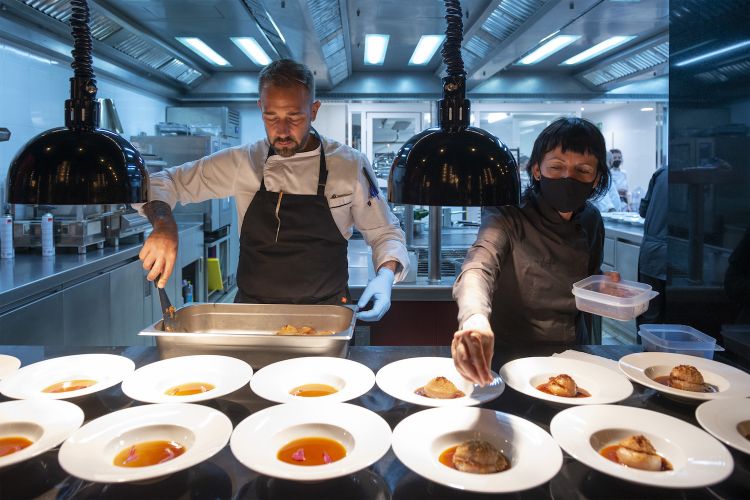
Fina Puidevall and his Sweet onion from the Croscat volcano filled with pecorino from Farró and cereal bread
, scientific coordinator of the
Volcano Active Foundation in Barcelona says that «volcanoes have always been crucial for rural development», even in his La Garrotxa, the ancient Catalan volcanic area. «Its soil is rich, there's lots of biodiversity. The eruptions cause social and economic benefits», and gives a very clear example: «When vegetables grow on basaltic soil, they are sweeter, they taste better», like the rare
Fesols de Santa Pau, PDO beans «that are only born here». And then: «A farmer from La Garrotxa sold some cows to a colleague from a nearby valley. He had to buy them back because they would no longer eat, they only wanted the grass born on volcanic soil», which is the best. Here: all these delicacies allow
Fina Puidevall and his daughter
Martina Puigvert, souls and chefs at
Les Cols, two Michelin stars in Olot, in the province of Gerona, right in the heart of the
Parque Natural de la Zona Volcánica de la Garrotxa (44 volcanoes!), to cook a dish – which we tasted – that is wonderful, elegant, rich:
Sweet onion from the Croscat volcano filled with pecorino from Farró and cereal bread, to which he pairs a royale of the same onion with liquorice. «At
Les Cols we make a volcanic, green and sustainable cuisine – says
Martina Puigvert – Sustainability is part of our lifestyle».
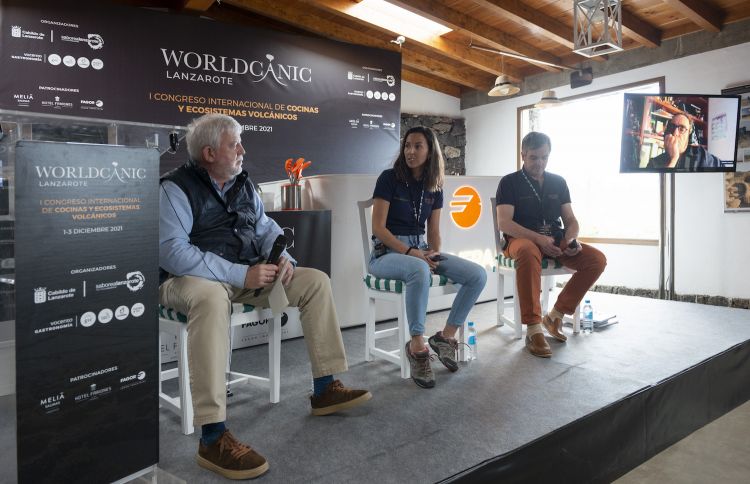
Debate and exhibition of volcanic cheese
If, as we saw above, cows and sheep prefer the volcanic pastures because the grass is better, can we imply that their milk will be full of special, unique, and perhaps better characteristics? The three representatives of the volcanic cheese districts that were present at
Worldcanic, that is to say
Yves Lubert, from Alvernia in France (
Cantal PDO cheese, delicious);
Arminda García, from Lanzarote; and
Salvador García-Arbos, from La Garrotxa, are convinced of this. The latter region is recovering a very special cheese, with a mouldy crust and a white paste, made with goat's milk from the Murcia and Granada breeds. As journalist
Salvador Garcia-Arbòs explained, its "birth" is very recent, back in 1980, and it grew by chance: «This cheese was born in La Garrotxa and then disappeared from this region and reappeared in other places. Right now, there are many emerging cheese factories that are launching other types of products, the most complex of which being with cow's milk. The pastures in volcanic areas are better, there's no doubt».
Arminda García at
Finca de Uga in Lanzarote makes around 20 types of cheese – two were awarded at the prestigious
World Cheese Awards – most of which from Majorera and Canaries goats. But is volcanic cheese really better?
Arminda: «The animals that graze on volcanic soil surely absorb these unique features of the territory. Which are then transferred into the milk and thus into the cheese».
Luberto: «Our cheese is richer in calcium, which is a defining feature».
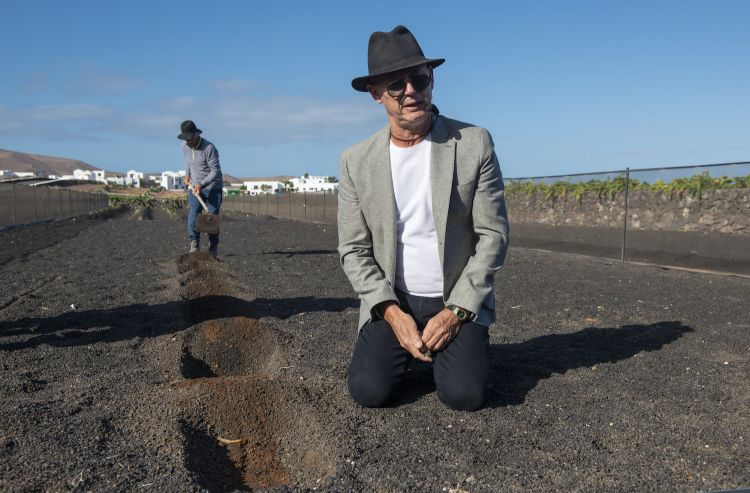
Toño Morales from ecofinca Vegacosta and the extraordinary fertility of the volcanic soil, covered in ashes
Finally, speaking of the fertility of volcanic soil, what better example than ecofinca
Vegacosta in Tinajo, Lanzarote? It has 120K square metres of sustainable farming based on volcanic ashes, which cover all the fields and don't need to be renewed, you just need to add a little natural fertiliser, «this base allows us to give life to unique products», says owner
Toño Morales, who shows with pride potatoes, chives, figs, lettuce, delicious strawberries, pitaya…
Toño managed this project with his daughter and strongly believes in a future that connects fine (volcanic) agriculture, gastronomy and tourism. He invests to preserve the local agricultural traditions – unknown to new generations – and to create a shop for local produce. He says: «We have the best prepared generations in history and we know well what we want: gastronomy, sustainability, knowledge… Ten years ago there was no project that united these fields». Now there is.
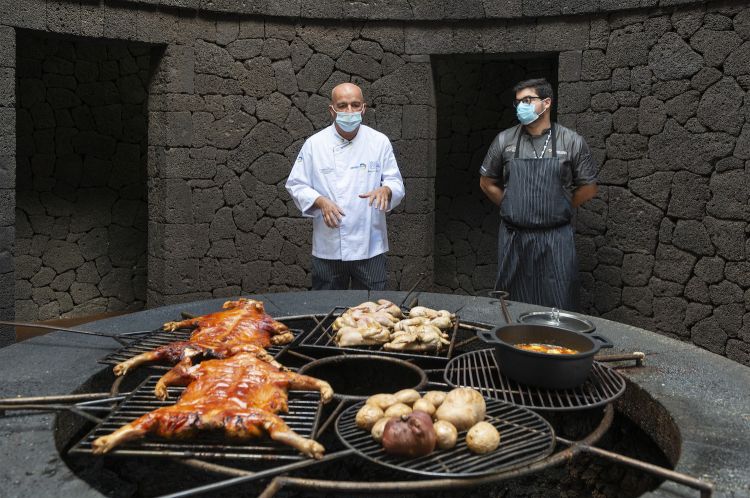
Cooking on a "crater" using the heat of the volcano's magma at El Diablo, a restaurant perched in the heart of the National Park of Timanfaya, on the Montañas del Fuego
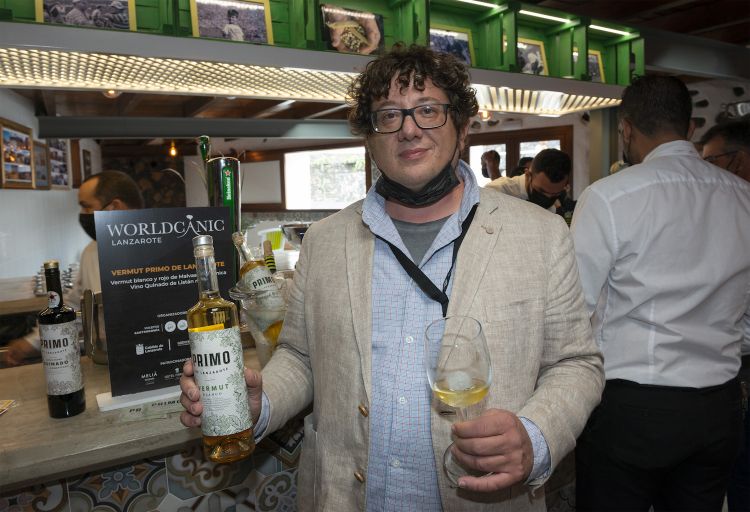
Davide Musci, originally from Torino, now based in Lanzarote – produces the first vermouth of the island. He called it Primo de Lanzarote
Of course we must end with a selection of the best food we ate in Lanzarote, prepared by local chefs (which is also a short tour of the island's best restaurants). Now, in terms of contemporary cuisine: the
Raw fish, kimchi juice and avocado from restaurant
Kaori in Puerto del Carmen was remarkable; the same applies to the Canarian cuisine, strongly product-based and regionally-inspired from
El Risco in Famara, which was also confirmed by a critic who knows the area well,
Xavier Agullò; the experience (first in terms of landscape and then of taste) at
El Diablo, a restaurant perched in the heart of the
National Park of Timanfaya, on the
Montañas del Fuego, was extraordinary. Here you can admire spectacular landscapes and "touch" the volcanic activity as well as taste dishes cooked directly on the heat of the magma (to be precise: they are cooked on pockets of volcanic magma that concentrated here after the eruption of Timanfaya in 1730): suckling pigs, vegetables, soups...
Kamezí Deli & Bistró, near Playa Blanca, on the southern tip of Lanzarote is also interesting: the restaurant is in the
Kamezí Senso Concept, a concept of luxury hotels with a design inspired by the island. In terms of traditional cuisine instead, the typical
gofio (a sort of cream made by milling various toasted cereals) is good, and most of all is the skin of fried moray eel at
Brisa Marina in Playa Blanca; other good recipes include the
puchero canario (a stew of beef, pork, chicken, sausage or pancetta cooked with chickpeas) at
La Bodega de Santiago in Yaiza; the
caldo de millo (a sweet corn soup with potatoes, saffron and spices, plus meat) at
Casa Brigida in Playa Blanca and the
Chickpeas with black pork or
La Piscina Club from La Santa; and the
Patellas with coriander mojo from
La Cascada del Puerto in Puerto del Carmen are rare and tasty.
Translated into English by Slawka G. Scarso